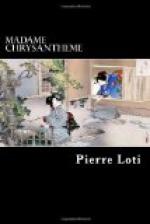Suddenly there are steps on the stairs, the light footsteps of barefooted women pattering over the white mats. No doubt the first course of my lunch just about to be served. I quickly fall back, fixed and motionless, upon my black velvet cushion. There are three of them now, three waiting-maids who arrive in single file, with smiles and curtsies. One offers me the spirit-lamp and the tea-pot, another preserved fruits in delightful little plates, the third, absolutely indefinable objects upon gems of little trays. And they grovel before me on the floor, placing all this plaything of a meal at my feet.
At this moment, my impressions of Japan are charming enough; I feel myself fairly launched upon this tiny, artificial, fictitious world, which I felt I knew already from the paintings of lacquer and porcelains. It is so exact a representation! The three little squatting women, graceful and dainty, with their narrow slits of eyes, their magnificent chignons in huge bows, smooth and shining as boot-polish, and the little tea-service on the floor, the landscape seen through the verandah, the pagoda perched among the clouds; and over all the same affectation everywhere, in every detail. Even the woman’s melancholy voice, still to be heard behind the paper partition, was so evidently the way they should sing, these musicians I had so often seen painted in amazing colors on rice-paper, half closing their dreamy eyes in the midst of impossibly large flowers. Long before I came to it, I had perfectly pictured this Japan to myself. Nevertheless in the reality it almost seems to be smaller, more finicking than I had imagined it, and also much more mournful, no doubt by reason of that great pall of black clouds hanging over us and this incessant rain.
* * * * *
While awaiting M. Kangourou (who is dressing himself it appears, and will be here shortly), it may be as well to begin lunch.
In the daintiest bowl imaginable, adorned with flights of storks, is the most wildly impossible soup made of sea-weed. After which there are little fish dried in sugar, crabs in sugar, beans in sugar, and fruits in vinegar and pepper. All this is atrocious, but above all unexpected and unimaginable. The little women make me eat, laughing much, with that perpetual irritating laugh, which is the laugh peculiar to Japan,—they make me eat, according to their fashion, with dainty chop-sticks, fingered with mannered grace. I am becoming accustomed to their faces. The whole effect is refined,—a refinement so utterly different from our own, that at first sight I understand nothing of it, although in the long run it may end by pleasing me.




